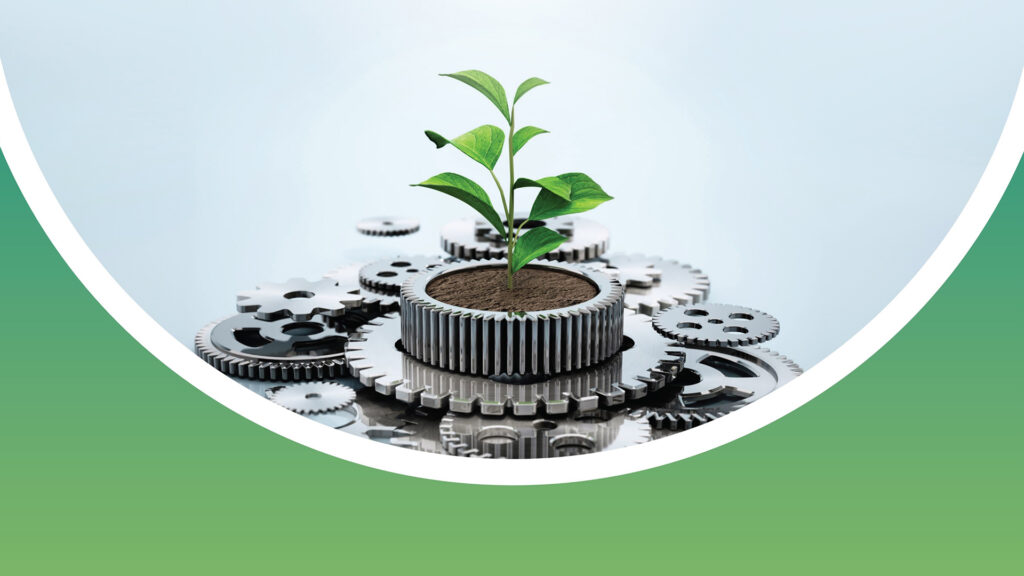The Sustcert4biobased project is dedicated to promoting sustainability certification for industrial bio-based systems to ensure a sustainable transition to a circular bio-based economy.
A successful transition from linear fossil-based systems to circulating bio-based systems must ensure environmental, social and economic sustainability. To this end, a Sustainability Certification Scheme and Label (CSL) has been developed to enable traceability and transparency of the impact of sustainability along the value chain and trade for responsible production and consumption within the EU and worldwide. It is essential that there is a way to assess the performance of these tools. This is where sustcert4biobased appears!
Sustcert4Biobased is a three-year Horizon Europe project that began in June 2022 and ended in May 2025. The consortium consists of Wageningen Research as a coordinator, Circe (research organization), ECOS (non-governmental organization), Control Union (certified organization), and White Studies (consulting organization).
approach
The Sustcert4biobased approach is shown in Figure 1. WP1 concerns identification, review and analysis of related CSLs. This includes sustainability certification schemes for bio-based products and materials (ISCC Plus, RSB Advanced products, better biomass) and biological raw materials (FSC). [wood]better cotton [cotton]Bonsucro [sugarcane]and Ecolabel (Eu Ecolabel, Nordic Swan Ecolabel). The holistic approach follows, taking equal consideration of all three pillars of sustainability (i.e., the environment, social and economics). Furthermore, cyclicity was included as a four dimension to ensure the contribution of bio-based products to the circular economy. WP2 provides a mapping of the current situation in the global trade flow of selected bio-based value chains, thereby providing an understanding of imports and exports to the EU and its certification levels.
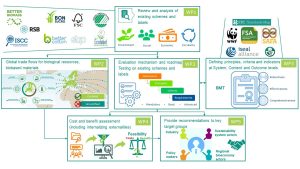
WP3 focuses on developing surveillance systems by reviewing and building existing monitoring/benchmarking tools and guidelines. The developed monitoring system is tested on selected CSLs to identify opportunities for improvement in each CSL. WP4 focuses on the cost and benefits assessment (CBA) of sustainability certification for bio-based systems, including internalization of externalities (environmental and social costs and benefits). The developed/adapted method is used in assessing the likelihood of adopting sustainability CSL in three selected bio-based value chains (chemical/plastics, textiles, wood).
The results of the project and the insights obtained along the way are then used to derive recommendations in WP5 for four main target groups: policy makers, schemes and standards owners, industrial bio-based value chain actors, and local bioeconomic actors.
Main output
Below is the main output from the Sustcert4biobased project:
Classification of biological resources and bio-based products (D1.1) Catalog of sustainability certification schemes and labels for industrial bio-based systems (D1.2) Identifying the most representative bio-based value chain in the EU Selected CSLS (D3.2) Cost-benefit analysis (CBA) (including internalization of externalities) for sustainability certification (D4.1-D4.4) Recommendations for target stakeholders (D5.1-D5.5)
More information about BMT and CBA is listed below. For more information about other results, see the related artifacts (in parentheses) at https://sustcert4biobased.eu/resources/deliveables or https://zenodo.org/communities/sustcert4biobased-project/records.
BiobasedCert Monitoring Tool
At the heart of our efforts is the development of surveillance systems to assess the effectiveness, robustness, and inclusiveness of existing CSLs in bio-based systems. This relates to CSL of biological resources for bio-based products and industrial bio-based value chains.
Instead of a project-specific monitoring system, it was decided to work together with two other projects funded under the same call, Harmonitor and Star4BBS, to develop a joint system called the Biobased Cert Monitoring Tool. BMT consists of three levels: system level, content level, and result level. The system level focuses on CSL system characteristics such as governance, traceability, and assurance. This level provides an assessment of the robustness of the scheme. Content level focuses on the requirements CSLS set for operators seeking authentication. This level provides an evaluation of the inclusiveness of CSL standards. The outcome level focuses on evidence of performance and impact generated by implementing CSL requirements. This level provides an assessment of the effectiveness of the scheme.
Sustcert4BioBased leads content-level development, collaborating in system and outcome-level development. Content levels can be divided into four aspects: environment, circulation, sociality and economics. Each dimension defines a set of principles, standards, and requirements. There are also high-level requirements that require CSL to require operators to comply with laws and regulations. Figure 2 provides an overview of content-level sustainability principles.
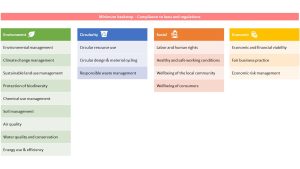
Each requirement is assigned one of three levels: mandatory, basic, or advanced. The required requirements are currently expected to be covered by the scheme. Basic requirements provide more normative details, while advanced requirements are ambitious requirements defined to promote continuous improvement. The results of the assessment are presented as a table, showing the percentage of applicable requirements covered by the CSL assessed for each level and for each principle.
BMTs are optimized using testing in selected CSLS, reviews by experts from accredited bodies, and involvement of additional stakeholders. Through testing of BMT on selected CSLs in close collaboration with CSL owners, gathering feedback on BMTs fine-tuned the requirements and evaluation mechanisms. A consulting expert at a certification body that aims to ensure a balance between practicality and inclusiveness of requirements. Additionally, engaging with various target stakeholders through workshops, bilateral meetings and research will improve the applicability and acceptance of BMT.
BMT aims to provide the European Commission with a framework to assess the potential of CSLS and accompanying standards to contribute to relevant EU policies and sustainability goals prioritized and sustainability goals in the Sustainable Development Goals (SDG). Additionally, BMT will support and incentivize CSL owners to improve the system by identifying BMT requirements that are not currently covered by the standards and governance processes.
Cost Benefit Analysis (CBA)
Sustcert4Biobased fills the gaps in CBA research by incorporating CBA externalities into the CBA methodology and understanding the true economic feasibility of adopting sustainability certification. This proposed new CBA methodology (see Figure 3) was used in assessing the feasibility of sustainability certification schemes for three bio-based value chains (i.e. sugarcane, cotton, and wood). The internal and external costs and benefits of authentication are taken into consideration. Internal costs include compliance costs such as training and audit fees, while internal profits improve price premiums and market positions. Externalities (environmental and social costs/benefits) that are positive or negative effects not reflected in transaction prices are evaluated using true cost accounting. Findings suggest that internal profits generally outweigh internal costs. However, data limitations prevent the full assessment of externalities. The lack of data is the fact that not only is the perceived sensitivity of the data, but not only is it reluctant for organizations to share it, it is necessary and therefore not to measure these externalities. Addressing these data limitations is important to increase the accuracy of CBAs in bio-based value chains. For example, standardized reporting requirements for important externalities can be introduced that will help policy makers tackle this challenge.
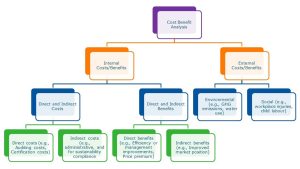
Impact and outlook
The Sustcert4Biobased consortium has managed to raise awareness among target stakeholders through a variety of channels, including physical events, online co-creation workshops, biennial networks of interest conferences, project websites and social media posts.
Sustcert4BioBased has produced significant outcomes and a wealth of data, information, methods and tools that can further enhance sustainability certification for bio-based systems.
As the transition to a cyclical, bio-based economy progresses, establishing sustainability standards for bio-based products, which can be defined using the findings of Sustcert4biobased, becomes increasingly important to ensure that efforts to reduce dependence on fossil fuels are also sustainable.
Furthermore, the use and recognition of BMT by EC is an important step to promote the potential harmony of existing CSLs. This will host ways to use CSLS in the EU joint regulatory framework to boost the market for sustainability-certified bio-based products.
European Union funding. However, there are some opinions and opinions expressed.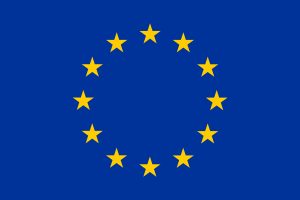 The authors alone do not necessarily reflect authors of the European Union or European Research Committee. Neither the European Union nor the permitting authority can be held liable for them.
The authors alone do not necessarily reflect authors of the European Union or European Research Committee. Neither the European Union nor the permitting authority can be held liable for them.
This article will also be featured in the 22nd edition of Quarterly Publication.
Source link

